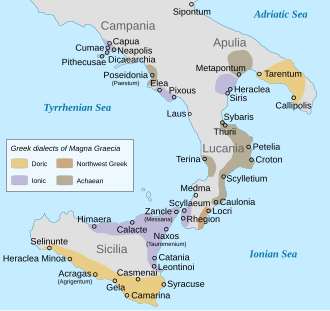| Attic Greek | ||||||
|---|---|---|---|---|---|---|
| Ἀττική Ἑλληνική | ||||||
| Region | Attica, Aegean Islands | |||||
| Era | c. 500–300 BC; evolved into Koine | |||||
Indo-European
| ||||||
Early form | ||||||
| Greek alphabet Old Attic alphabet | ||||||
| Language codes | ||||||
| ISO 639-3 | – | |||||
grc-att | ||||||
| Glottolog | atti1240 | |||||
Distribution of Greek dialects in Greece in the classical period.[1]
Distribution of Greek dialects in Magna Graecia (Southern Italy and Sicily) in the classical period.
| ||||||
Attic Greek is the Greek dialect of the ancient region of Attica, including the polis of Athens. Often called classical Greek, it was the prestige dialect of the Greek world for centuries and remains the standard form of the language that is taught to students of ancient Greek. As the basis of the Hellenistic Koine, it is the most similar of the ancient dialects to later Greek. Attic is traditionally classified as a member or sister dialect of the Ionic branch.
- ^ Roger D. Woodard (2008), "Greek dialects", in: The Ancient Languages of Europe, ed. R. D. Woodard, Cambridge: Cambridge University Press, p. 51.

